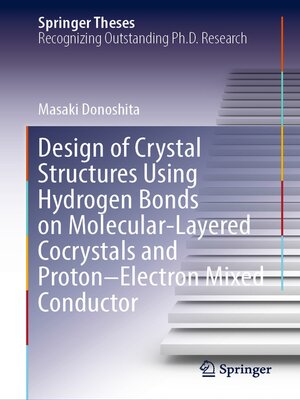Design of Crystal Structures Using Hydrogen Bonds on Molecular-Layered Cocrystals and Proton–Electron Mixed Conductor
ebook ∣ Springer Theses
By Masaki Donoshita

Sign up to save your library
With an OverDrive account, you can save your favorite libraries for at-a-glance information about availability. Find out more about OverDrive accounts.
Find this title in Libby, the library reading app by OverDrive.



Search for a digital library with this title
Title found at these libraries:
| Loading... |
This thesis addresses the design of crystal structures using hydrogen bonds. In particular, it focuses on the design of functionalities and the control over the packing of molecular assemblies, based on molecular designs.
Firstly, the synthesis and evaluation of a proton–electron mixed conducting charge transfer salt is reported. Focusing on the difference in the strength of hydrogen bonds and weaker intermolecular interactions, a system was rationally designed and constructed where electron-conducting molecular wires were encapsulated within a proton-conducting matrix. Next, the investigation of structural phase transitions in a cocrystal consisting of hydrogen-bonded two-dimensional molecular assemblies is reported. Drastic rearrangements of hydrogen-bonded molecular assemblies in the cocrystal led to single-crystal-to-single-crystal phase transitions, resulting in anisotropic changes in the crystal shape. Furthermore, chemical modification of a component molecule in the cocrystal is reported. The modification afforded control over the stacking patterns of the two-dimensional molecular assemblies, i.e., sheets, and the mechanism was discussed considering the intersheet intermolecular interactions and molecular motion.
It is suggested that hydrogen bonds are beneficial to construct molecular assemblies in molecular crystals because of their strength and well-defined directionality, and the consideration of coexisting weaker intermolecular interactions can lead to the design of whole crystal structures and, hence, functionalities. This thesis benefits students and researchers working on solid-state chemistry by presenting various methods for characterizing and evaluating the properties of molecular solids.
Firstly, the synthesis and evaluation of a proton–electron mixed conducting charge transfer salt is reported. Focusing on the difference in the strength of hydrogen bonds and weaker intermolecular interactions, a system was rationally designed and constructed where electron-conducting molecular wires were encapsulated within a proton-conducting matrix. Next, the investigation of structural phase transitions in a cocrystal consisting of hydrogen-bonded two-dimensional molecular assemblies is reported. Drastic rearrangements of hydrogen-bonded molecular assemblies in the cocrystal led to single-crystal-to-single-crystal phase transitions, resulting in anisotropic changes in the crystal shape. Furthermore, chemical modification of a component molecule in the cocrystal is reported. The modification afforded control over the stacking patterns of the two-dimensional molecular assemblies, i.e., sheets, and the mechanism was discussed considering the intersheet intermolecular interactions and molecular motion.
It is suggested that hydrogen bonds are beneficial to construct molecular assemblies in molecular crystals because of their strength and well-defined directionality, and the consideration of coexisting weaker intermolecular interactions can lead to the design of whole crystal structures and, hence, functionalities. This thesis benefits students and researchers working on solid-state chemistry by presenting various methods for characterizing and evaluating the properties of molecular solids.






